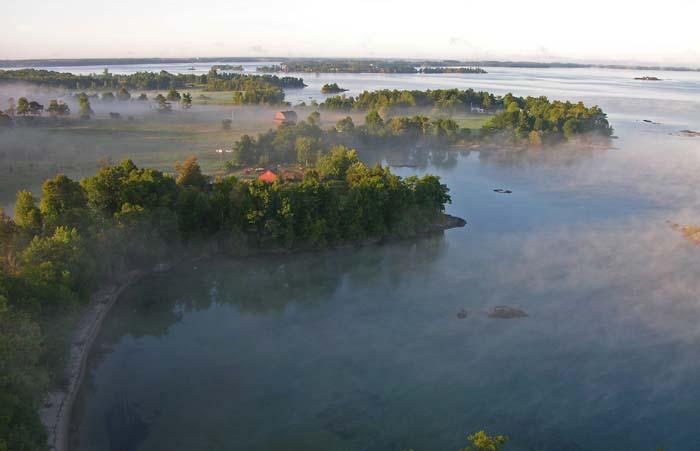Disengaged from the larger mainland, life on Grindstone Island has gone on year-round, remote from many changes of the twentieth century. To hike these dirt roads, without electrical power lines or automobiles, is to be back two centuries ago, when the large island was settled. Some of the families on the island have been here for many generations, isolated for much of the year when crossing the river was, and continues to be, dangerous.
Grindstone Island is a magical place, often enchanting but sometimes frightening because of its isolation. Memoirs of old-time residents recall many crises, especially during the long winter when help from the mainland was uncertain.
Two one-room school houses on the island served generations of youngsters. The "Little Red Schoolhouse" was the last one-room school operated in New York State. When older, youngsters usually spent the winter on the mainland, in order to attend the Clayton high school. Leon Rusho (in the second row on the right, above) has recalled "A Boy's Life on Grindstone Island" in the online documentary, Tales of the River.
The seasonal community here is remarkably tenacious, like the year-round residents. The summer colony at the head of the island was established in the 1880s and some families (many have become interrelated over the years) have been here for many generations.
Grindstone Islanders get together often at Dodge Hall, sometimes for an old-fashioned square dance (above). The one church on the island welcomes all. The congregation is comprised of members of more than fifty denominations. The island community supports the Grindstone Island Research and Heritage Center, housed in the Little Red Schoolhouse.
Families who have enjoyed the remote haven of Grindstone Island for generations have been vigilant about protecting its qualities. Ken Deedy has been in the forefront of conservation, not merely on Grindstone Island, but throughout the region. He was one of the founders of the Thousand Islands Land Trust.
Large areas of Grindstone Island have been protected by the Thousand Islands Land Trust, so that its scenic landscape may remain undeveloped. Potters' Beach, for instance, would be prime real estate otherwise. It remains natural, however, although high recreational use by visiting boaters requires constant maintenance by TILT clean-up volunteers.
One of the most spectacular photographs of Grindstone Island was taken from the air by Ian Coristine. Grindstone is the fourth largest Island. (after Wolfe, Howe, and Wellesley islands). A circuit around it is a sixteen-mile cruise. Canoe and Picnic Point State Parks are at the foot of the island. Potters' Beach appears at the left, with the Lake Fleet Islands off the north shore of the island, above. Clayton appears at the right edge of the picture, Wellesley Island at the top.










